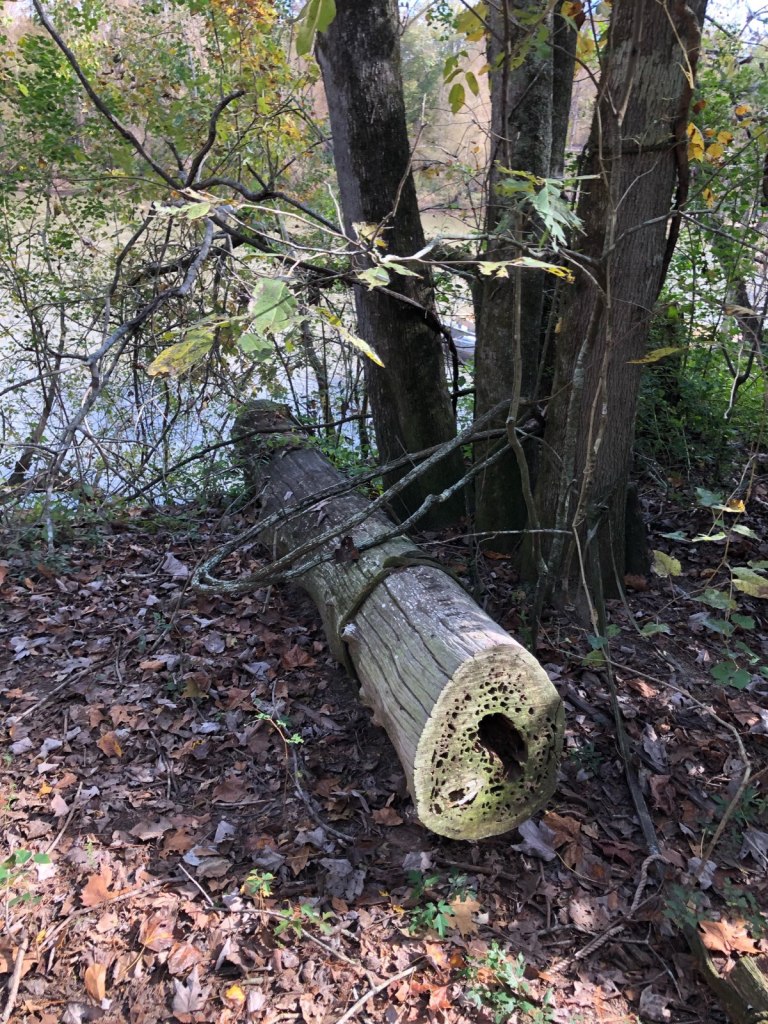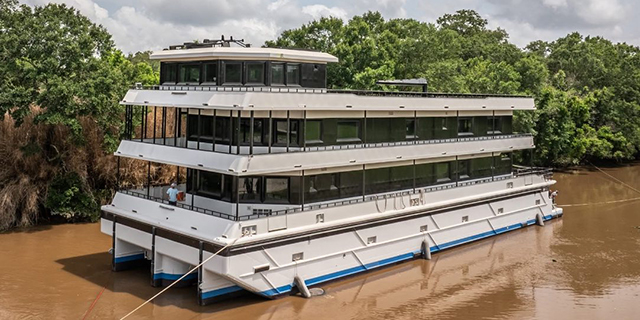Latiolais finds, extracts huge, centuries-old ‘sinker’ cypress
Published 8:00 am Monday, December 4, 2023

- More manageable recovered cypress trees like this one have been hauled to Kevin Latiolais' home in the Atchafalaya Basin. Latiolais was able to cut this one, about 17 inches in diameter and approximately 36- to 40-feet long. It also shows "pecky" and "wind sway" effects, the former for valued woodworking and the latter not so much. He had to cut it into 3 pieces to be able to transport it.
Majestic cypress trees standing tall and straight for centuries across the Atchafalaya Basin have been called “Sentinels of the Swamp.”
As a resident of the Atchafalaya Basin since around 2009, Kevin Latiolais certainly appreciates cypress trees, bald cypress trees to be exact. He simply calls them “swamp gold.”
On Sept. 8, the retired offshore oil field boss unearthed a golden relic partially buried in the muck along the canal that connects Bayou Benoit to Grand Bayou. Latiolais got his hands on a 21-foot long, 1,400- to 1,500-year old “sinker” cypress tree log weighing an estimated 7,000 pounds that could command thousands of dollars on the market.
Due to two slight imperfections — hollow parts and “wind shake” (stress at the bottom of the cypress tree) — it is less valuable than he hoped.
“I wish it would have been a nice, pristine log. I would have made some money off it. I’ll still make money,” Latiolais said the second week of November.
Old-growth cypress trees are prized both for their construction and ornamental values from housing to furniture, particularly tables and cabinets, to boats.
Their own oily resin make them water resistant, decay resistant and repels most insects. As a result, cypress tree wood is durable and long-lasting indoors and outdoors.
Underwater, their beauty and strength are preserved.
Most old-growth cypress trees are even more beautiful inside than outside. There are vibrant oranges, blues and reddish colors in the interior, Kevin Latiolais said, due to their chemistry.
It was a labor of love to move the huge cypress tree log with a 40-inch diameter from its underwater resting place to Bayou Benoit Landing to his cousin’s yard in Catahoula. He’s proud of the effort that produced such a cypress tree.
“When I pulled it out of the ground, I said, ‘It’s way too big for me to cut. Look at this thing,’ ” Latiolais said.
“It was an interesting adventure,” Brian Latiolais of St. Martinville, his cousin, said.
A six-year wait to extract it
The adventure got underway in the mid-2010s.
“I’ve been watching that log about six years. Any time it (Atchafalaya River stage at Butte La Rose) would get to 4, I’d hide it with lilies,” Kevin Latiolais said.
The swamp gods were with him when he first spotted it. He always keeps an eye out for “sinker” cypress trees, as they are known in the business. The butt end of the log was in the middle of the canal while the other end was up against the bank.
“I was lucky to see it, lucky to find it. I’ll put it that way,” he said.
At first, he said, there was no need to camouflage it to keep it hidden because a tupelo gum tree grew on top. Dead roots surrounded it.
He finally had the resources, i.e. heavy equipment, available to do something about recovering it late this summer. He helped someone he knew drive pilings for docks for three or four days in and around the Atchafalaya Basin.
When they finished pile-driving, the heavy equipment operator positioned a dredge that scooped mud from either side of the cypress tree. (See related video.) That enabled Latiolais to tie it to a barge and tow it about a mile to Bayou Benoit Landing.
That’s where it got interesting.
His cousin’s pickup truck and 21-foot flatbed trailer were waiting at the boat ramp. Brian Latiolais’ gear included a 6,000-pound electric winch.
The 48-year-old outdoorsman who builds boats, makes furniture and repairs guns said the original winch “burned up” during the process. He used another winch with a multi-part line that increased its pulling capacity from 2,000 to 4,000 pounds.
Still, he said, after the bulk of the log was on the flatbed trailer, they had to back into the water, winch a little bit, back down some more, winch a little bit, and so on.
By the time the entire log was on the flatbed trailer, the rear end of his pickup truck was in the water, according to Brian Latiolais.
A violent afternoon thunderstorm delayed the loading of the cypress tree for a few hours. There was added stoppage time, Brian Latiolais said, as boaters, including a local outdoors writer, at the boat ramp asked about it.
A heavy conversation piece
“We probably lost an hour talking to people (about the cypress tree and what the two men were doing with it). It’s an interesting subject. Fascinating,” he said.
The log’s weight was too much for the flatbed trailer, which suffered a few broken boards and a broken axle that caused a tire to roll into the woods along the West Atchafalaya Basin Protection Road.
“He was so happy to get to his house without major damage,” Kevin Latiolais said.
There’s more to the rich history of that cypress tree the cousins brought in from the nation’s last great overflow swamp.
Eric Couvillion, a master craftsman who owns Live Edge Woodworks in Breaux Bridge, met with them in October. Couvillion, who also aged the cypress tree, pointed out marks on it from Acadiana’s past – a thriving cypress tree logging industry.
“The guy said the tree was cut with an axe between 1900 and 1920. You can tell,” Kevin Latiolais, said, noting the axe cut is visible ¾ through the cypress tree. It’s also apparent bevels and a cross-cut saw were used.
Why did it end up on the bottom in the swamp? The theory is loggers saw the hollow spots and “wind shake,” gave it a thumbs down and left it there, according to Couvillion.
Long before the Civil War, loggers cut lumber and tied sinkers and floaters together to transport. Sometimes a cypress tree would fall off the craft and be lost forever … well, sometimes.
Like Latiolais’ cypress tree, they still are being discovered. For example, Couvillion extracts up to 10 felled trees from private land annually during low-water periods with heavy construction equipment and, occasionally, a tugboat.
Kevin Latiolais lives near the T intersection of the G.A. Cut and Grand Bayou on the high east bank of the G.A. Cut. He lives off the land and the water.
The all-around outdoorsman grew up in the Loreauville area close to Lake Dauterive. He hunted and fished with his father, the late Dewey Latiolais, and learned to appreciate and respect nature, the land, the water and the wildlife.
He later chose the oil field industry as his career and worked 36 years before retiring as an offshore installation manager, 28 days on, 28 days off, for Hercules Offshore Inc.
After his retirement, Latiolais moved into the nation’s last great overflow swamp 14-15 years ago. He was in his element.
Latiolais lives the outdoors life
“Oh, yeah. That’s all I do. When I wake up in the morning, if I want to go fishing, I go fishing,” he said, noting it’s the same for hunting squirrels, rabbits or deer in season.
His interest in harvesting old-growth cypress tree took off years ago. He recently found a rare, extremely valuable “Pecky” cypress tree and cut it into three sections.
“Pecky” is the name for an unusual variety of “sinker” cypress trees. They have irregularly shaped holes in the heartwood that sets them apart from others.
The “Pecky” holes are caused by a type of fungus that makes hollow tubes running vertically throughout the cypress tree when it’s alive. The fungus doesn’t germinate until the tree is around 125 years old.
Latiolais’ “Pecky” cypress tree just might be worth more than the huge log that got the attention of Couvillion.
“I remember the log very well. We had a long conversation about it. That was a good tree. (But) it wasn’t a log I could do anything about it,” Couvillion said Nov. 29, a few minutes after leaving his property along the East Atchafalaya Basin Protection Levee near Ramah, where he just set up a deer stand.
Couvillion, a 69-year-old outdoorsman who retired last year after 44 years in the oil field and pipeline business, graduated with a botany degree from the University of Southwestern Louisiana. His woodworking business, which specializes in making cypress tables, has what he believes is the largest saw in the state.
“I’ve been in this work all my life. I eat, sleep and live this stuff,” he said.
To a lesser extent, so does Kevin Latiolais. His Sentinel of the Swamp continues to be a conversation piece.
“Everybody’s impressed with it. I wish it was a pristine log. But I’m still impressed,” he said, noting he and his cousin still are deciding what to do with it.





